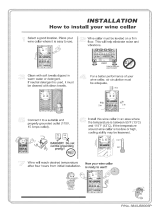
5
Do not obstruct the fan (if included) with food
items.
After placing the food check that the door of
the compartments closes properly, especially
the freezer door.
Damaged gaskets must be replaced as soon
as possible.
Use the refrigerator compartment only for
storing fresh food and the freezer compartment
only for storing frozen food, freezing fresh food
and making ice cubes.
Avoid storing unwrapped food in direct
contact with internal surfaces of the refrigerator
or freezer compartments.
Appliances could have special compartments
(Fresh Food Compartment, Zero Degree Box,
etc.). Unless specified in the specific booklet of
product, they can be removed, maintaining
equivalent performances.
C-Pentane is used as blowing agent in the
insulation foam and it is a flammable gas.
Installation
The appliance must be handled and installed
by two or more persons - risk of injury. Use
protective gloves to unpack and install - risk of
cuts.
Installation, including water supply (if any)
and electrical connections, and repairs must be
carried out by a qualified technician. Do not
repair or replace any part of the appliance
unless specifically stated in the user manual.
Keep children away from the installation
site. After unpacking the appliance, make sure
that it has not been damaged during transport.
In the event of problems, contact the dealer or
your nearest After-sales Service. Once installed,
packaging waste (plastic, styrofoam parts etc.)
must be stored out of reach of children - risk of
suffocation. The appliance must be
disconnected from the power supply before any
installation operation - risk of electric shock.
During installation, make sure the appliance
does not damage the power cable - risk of fire
or electric shock. Only activate the appliance
when the installation has been completed.
Be careful not to damage the floors (e.g.
parquet) when moving the appliance. Install the
appliance on a floor or support strong enough
to take its weight and in a place suitable for its
size and use. Make sure the appliance is not
near a heat source and that the four feet are
stable and resting on the floor, adjust as
required, and check that the appliance is
perfectly level using a spirit level. Wait at least
two hours before switching the appliance on, to
ensure that the refrigerant circuit is fully
efficient.
WARNING: To avoid a hazard due to
instability, positioning or fixing of the appliance
must be done in accordance with the
manufacturer instructions. It is forbidden to
place the refrigerator in such way that the metal
hose of gas stove, metal gas or water pipes, or
electrical wires are in contact with the
refrigerator back wall (condenser coil).
All dimensions and spacing needed for
installation of the appliance are in the
Installation instruction booklet.
Electrical warnings
It must be possible to disconnect the
appliance from the power supply by unplugging
it if plug is accessible, or by a multi-pole switch
installed upstream of the socket in accordance
with the wiring rules and the appliance must be
earthed in conformity with national electrical
safety standards.
Do not use extension leads, multiple
sockets or adapters. The electrical components
must not be accessible to the user after
installation. Do not use the appliance when you
are wet or barefoot. Do not operate this
appliance if it has a damaged power cable or
plug, if it is not working properly, or if it has
been damaged or dropped.
If the supply cord is damaged, it must be
replaced with an identical one by the
manufacturer, its service agent or similarly
qualified persons in order to avoid a hazard -
risk of electric shock.
Cleaning and maintenance
WARNING: Ensure that the appliance is
switched off and disconnected from the power
supply before performing any maintenance
operation; never use steam cleaning equipment
- risk of electric shock.
Do not use abrasive or harsh cleaners such
as window sprays, scouring cleansers,
flammable fluids, cleaning waxes, concentrated
detergents, bleaches or cleansers containing
petroleum products on plastic parts, interior




















